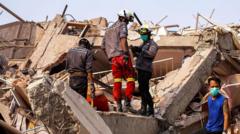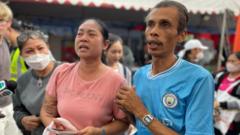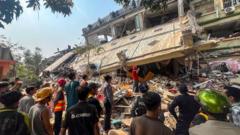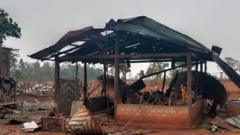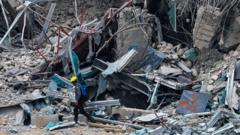The aftermath of a devastating earthquake in Myanmar has been overshadowed by significant internet restrictions imposed by the military junta, limiting communication and information flow.
Internet Shutdown in Myanmar Obscures Earthquake Damage Assessment

Internet Shutdown in Myanmar Obscures Earthquake Damage Assessment
Severe censorship complicates aid efforts after a 7.7-magnitude earthquake.
The 7.7-magnitude earthquake that struck central Myanmar around 12:50 p.m. local time on Friday has caused considerable damage, and its tremors were felt as far away as Bangkok, Thailand. However, information regarding the quake's impact in Myanmar remains sparse, primarily due to the ruling military junta's stringent internet censorship. The junta has systematically cut internet access and limited social media to control dissent since seizing power in 2021.
With established communications channels disrupted by the quake and ongoing connectivity issues from government restrictions, the situation is desperate. Official government websites struggled to remain accessible following the disaster. As mentioned by Joe Freeman, a Myanmar researcher at Amnesty International, areas with ongoing rebel conflicts suffer from exceptionally poor internet access, often resorting to satellite services like Starlink for connectivity.
In stark contrast, neighboring Thailand has seen extensive media coverage of the earthquake's ramifications, from videos to real-time social media posts documenting the damage. Freeman highlights the effectiveness of Myanmar's censorship policies in creating an information vacuum, stating, "Compare the coverage of the earthquake in Thailand, where tremors and damage have been extensively reported, to Myanmar, where we still don’t have a clear picture of the extent of the damage and loss."
This digital silence is a far cry from the pre-coup environment in Myanmar, where a burgeoning population of smartphone users actively engaged online, sharing everything from memes to serious political discourse. As humanitarian efforts begin, the lack of accurate data poses significant challenges for aid delivery, severely impacting the ability to respond to the disaster's full scale.
The ongoing impact of the junta’s control on communication underscores the critical need for reliable information and transparency, especially during emergencies such as this devastating earthquake.
With established communications channels disrupted by the quake and ongoing connectivity issues from government restrictions, the situation is desperate. Official government websites struggled to remain accessible following the disaster. As mentioned by Joe Freeman, a Myanmar researcher at Amnesty International, areas with ongoing rebel conflicts suffer from exceptionally poor internet access, often resorting to satellite services like Starlink for connectivity.
In stark contrast, neighboring Thailand has seen extensive media coverage of the earthquake's ramifications, from videos to real-time social media posts documenting the damage. Freeman highlights the effectiveness of Myanmar's censorship policies in creating an information vacuum, stating, "Compare the coverage of the earthquake in Thailand, where tremors and damage have been extensively reported, to Myanmar, where we still don’t have a clear picture of the extent of the damage and loss."
This digital silence is a far cry from the pre-coup environment in Myanmar, where a burgeoning population of smartphone users actively engaged online, sharing everything from memes to serious political discourse. As humanitarian efforts begin, the lack of accurate data poses significant challenges for aid delivery, severely impacting the ability to respond to the disaster's full scale.
The ongoing impact of the junta’s control on communication underscores the critical need for reliable information and transparency, especially during emergencies such as this devastating earthquake.







